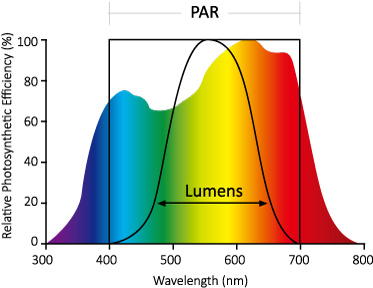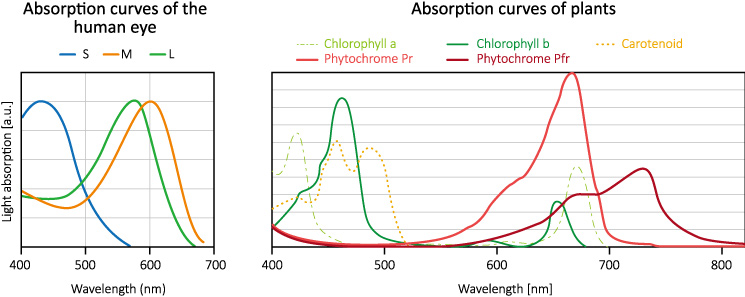Core Concepts
PAR, PPF, PPDF and DLI
PAR (Photosynthetically Active Radiation)
PAR (Photosynthetically Active Radiation) is NOT a measurement or “metric” like feet, inches, or kilos. Rather, it defines the type of light on spectrum of light where plants respond the best by photosynthesis. Through photosynthesis, plants convert light energy into chemical energy, which is the food they use to grow and thrive. In plants, the light is mainly reacting with Chlorophyll a and b.
PAR looks typically at the wavelength range of 400nm to 700nm.
In the PAR zone we measure the light which falls on the crop, which is expressed as PPFD or Photosynthetic Photon Flux Density in micromoles per meter per second µmol/sm² – see picture on the right.
PAR looks typically at the wavelength range of 400nm to 700nm.
In the PAR zone we measure the light which falls on the crop, which is expressed as PPFD or Photosynthetic Photon Flux Density in micromoles per meter per second µmol/sm² – see picture on the right.

In the past we always expressed the light levels in greenhouses in Lux.
Lux or Lumens is a measure of perceived light by the human eyes which typically react on white light.
Our eyes have 3 receptors for light, the S, M and L receptors, which are reacting mainly on blue, green and yellow light.
The curve where lumens and lux are measured is illustrated above – as you can see the start and end point is the same as the PAR zone, but blue light and red light are not taken into account as much as when we measure plant lighting.
Lux or Lumens is a measure of perceived light by the human eyes which typically react on white light.
Our eyes have 3 receptors for light, the S, M and L receptors, which are reacting mainly on blue, green and yellow light.
The curve where lumens and lux are measured is illustrated above – as you can see the start and end point is the same as the PAR zone, but blue light and red light are not taken into account as much as when we measure plant lighting.

Above illustration shows the difference between the light sensitivity of human eyes and the sensitivity of plants.
As plants chlorophyll production is the most effective with blue and red light photons, we can’t express the light levels of LED grow lights any more in Lux like we used to do.
Therefore the new measure is expressed in micromoles per meter per second and includes all the light photons from 400 nanometer up to 700 nanometer.
As plants chlorophyll production is the most effective with blue and red light photons, we can’t express the light levels of LED grow lights any more in Lux like we used to do.
Therefore the new measure is expressed in micromoles per meter per second and includes all the light photons from 400 nanometer up to 700 nanometer.
Photosynthetic Photon Flux (PPF)
The PPF or Photosynthetic Photon Flux is the total amount of light in the PAR zone that is produced by a light source each second. So PPF measures the “photosynthetically active photons emitted by a lighting system per second”. Expressed in μmol/second.
With the PPF of a grow light, you can calculate or estimate how many lamps you are going to need per area to reach your required light level on the plants. The PPF does not tell us how much of the measured light actually lands on the plants or any other surface.
So keep in mind not every lamp with the same PPF is as effective in bringing that light down to the crops.
Neither it tells us something on the spectrum of the light and the wavelength of these photons.
More about that you can discover below.
With the PPF of a grow light, you can calculate or estimate how many lamps you are going to need per area to reach your required light level on the plants. The PPF does not tell us how much of the measured light actually lands on the plants or any other surface.
So keep in mind not every lamp with the same PPF is as effective in bringing that light down to the crops.
Neither it tells us something on the spectrum of the light and the wavelength of these photons.
More about that you can discover below.
Photosynthetic Photon Flux Density (PPFD)
The Photosynthetic Photon Flux Density (PPFD) measures the light that actually arrives at the crop canopy in the Par zone.
The amount of light that actually reaches your plants within the PAR region or the number of photosynthetically active photons that fall on a given surface each second. The PPFD is expressed in μmol/s.m².
The PPFD as of today is the best available measure to compare grow lights in the market. On lamp level the manufacturer specifies the PPF or light output of the grow light in the PAR zone. Together with the light distribution of the lamp and the physical placement of the lamps on the project, the PPFD can be simulated. You can easy see that lamps with a similar light level sometimes don’t give similar results on PPFD on the crops, which mainly comes from the differences in light distribution.
The amount of light that actually reaches your plants within the PAR region or the number of photosynthetically active photons that fall on a given surface each second. The PPFD is expressed in μmol/s.m².
The PPFD as of today is the best available measure to compare grow lights in the market. On lamp level the manufacturer specifies the PPF or light output of the grow light in the PAR zone. Together with the light distribution of the lamp and the physical placement of the lamps on the project, the PPFD can be simulated. You can easy see that lamps with a similar light level sometimes don’t give similar results on PPFD on the crops, which mainly comes from the differences in light distribution.
So the art of correct lighting is to make sure the light is in the first place well distributed with a minimum of light fluctuations on the crop, but in the second place to ensure a maximum of light falling as direct as possible on the plants with a minimum of light spill.
This also explains why LED grow lights foreseen from advanced optics outperform those without optical controls.
Similar to white light applications, a LED emitter has a rather large light distribution – without corrections by optics controls a big piece of the emitted PPF energy doesn’t land on the canopy where you want it.
Optical controls by TIR (Totally Internal Reflection) lenses also improves the leaf canopy penetration in a similar way a diffuse greenhouse glass creates more light scattering and a better homogeneous light distribution over the grass.
This also explains why LED grow lights foreseen from advanced optics outperform those without optical controls.
Similar to white light applications, a LED emitter has a rather large light distribution – without corrections by optics controls a big piece of the emitted PPF energy doesn’t land on the canopy where you want it.
Optical controls by TIR (Totally Internal Reflection) lenses also improves the leaf canopy penetration in a similar way a diffuse greenhouse glass creates more light scattering and a better homogeneous light distribution over the grass.
Daily Light Integral (DLI)
The Daily Light Integral (DLI) measures the total amount of light that is delivered to a plant every day.
DLI is a cumulative measurement of the total number of photons that reach the plants and algae during the daily photoperiod.
The DLI measures the number of “moles” of photons in the Par region per square meter per day and is expressed as mol/d.m².
The DLI is a good way to implement in the light strategy in greenhouse project with supplemental lighting. For most crops you can define what is the ideal total light sum per day they can efficiently use.
DLI is a cumulative measurement of the total number of photons that reach the plants and algae during the daily photoperiod.
The DLI measures the number of “moles” of photons in the Par region per square meter per day and is expressed as mol/d.m².
The DLI is a good way to implement in the light strategy in greenhouse project with supplemental lighting. For most crops you can define what is the ideal total light sum per day they can efficiently use.
Photon Efficiency
The higher the number, the more efficient a lighting system is at converting electrical energy into photons of PAR.
But remember this number doesn’t tell us anything about the effectiveness of the light on your crops and doesn’t count the light frequencies above 700nm.
But remember this number doesn’t tell us anything about the effectiveness of the light on your crops and doesn’t count the light frequencies above 700nm.
Photon Efficiency refers to how efficient a horticulture lighting system is at converting electrical energy into photons of PAR.
With the PPF and the input wattage, you can calculate the efficiency. Expressed in µmol/J.
With the PPF and the input wattage, you can calculate the efficiency. Expressed in µmol/J.
Contact us
Request turf care advice
Request a turf care advice
Are you looking to ensure grass growth and recovery throughout the year, while maintaining a consistently strong and healthy turf pitch?
We can help you reach your goals through our innovative turf care systems and data driven approach. With our innovative approach, we aim to become your reliable and innovation partner in providing a diverse range of turf care and growlight solutions.
We can help you reach your goals through our innovative turf care systems and data driven approach. With our innovative approach, we aim to become your reliable and innovation partner in providing a diverse range of turf care and growlight solutions.
Pages
Contact
Stogger Engineering BV
Maasbreeseweg 55a
5988 PA Helden
the Netherlands
Maasbreeseweg 55a
5988 PA Helden
the Netherlands



